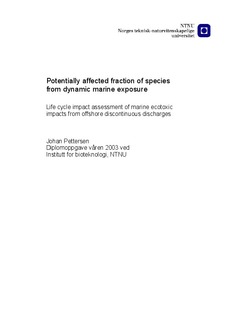| dc.contributor.author | Pettersen, Johan | nb_NO |
| dc.date.accessioned | 2014-12-19T12:34:51Z | |
| dc.date.available | 2014-12-19T12:34:51Z | |
| dc.date.created | 2007-02-27 | nb_NO |
| dc.date.issued | 2004 | nb_NO |
| dc.identifier | 122134 | nb_NO |
| dc.identifier.uri | http://hdl.handle.net/11250/242617 | |
| dc.description.abstract | For any substance that is used and discharged offshore the contractor has to choose the best alternative in relation to the effects of the substance upon discharge. Any environmental impact that the choice might have in other localities related to either processes before the product is used (e.g. raw material extraction and refining), or in the following treatment of byproducts (offshore or on shore) are neglected. Basing the selection of products solely on the potential marine toxicological impact of the substances will systematically prioritize small local improvements to greater improvement potentials in production or internal and external recycling.
Life cycle impact assessment (LCA) is a tool developed for environmental evaluation of entire product systems; that is all processes for from raw material production to the end-of-life treatment of the product. Material input and output streams to the processes are converted to environmental impacts in the life cycle impact assessment (LCIA) stage of LCA. Characterization factors are used to quantify the impact within impact groups.
Eco-indicator 99 and the CLM problem oriented approach (CML-POA) are two LCIA methods that include characterization factors for eco-toxic impacts. Both methods use adapted versions of the EUSES/SimpleBox model to simulate the fate of substances, but the methods do not apply the same definition of eco-toxic damage to quantify the relative impact of different substances. Eco-indicator 99 uses the Potentially affected fraction of species (PAF), while CML-POA uses the Risk Characterization Ratio. EUSES/SimpleBox is a multi media steady-state fate model, and concentrations in different environmental media are calculated from annual continuous emissions.
Offshore discharges are distributed in time and space. The resulting concentrations are high compared to the concentration in the total marine volume, and the affected volume is limited. Given the discontinuous properties of exposure from offshore discharges the EUSES/SimpleBox model is not suited to model such emissions.
A method to calculate characterization factors for discontinuous offshore discharges is proposed in this study. The method is based on the PAF as defined in the Eco-indicator 99 method. Changes from the Eco-indicator 99 method are:
• Replacement of the static hazard unit increase with a time integrated function to better describe the time dependant exposure from offshore discharges.
• Replacement of the static total marine volume with the time integrated volume.
The resulting dynamic marine exposure PAF (dme-PAF) is compatible with the ecotoxicity characterization factors in Eco-indicator 99. It is proposed to omit the acute period in the time integrals and only assess the chronic exposure period beginning from day four.
The Dose-related risk and effect assessment model (DREAM) is used to simulate the time variation of offshore discharges. DREAM is used today by Statoil in environmental risk assessments of such discharges. The model is not a multi-media fate model although it includes most of the processes that are part of the EUSES/SimpleBox model. DREAM produces time dependant profiles of discharges. These are used to calculate the time integrals in the dme-PAF method.
Simulations were performed to calculate ecotoxicity characterization factors for glutaraldehyde with the dme-PAF method. The simulations performed show that one of the settings in DREAM will have great influence on the resulting characterization factors, namely the lower concentration limit (LCL). DREAM calculates concentration in cells, and this data is stored and can be extracted in text format. Cells with concentrations below LCL will not be stored and the volume of these cells will be neglected. In order to be able to calculate dme-PAF properly LCL should be set at zero. This will maximize the number of recorded cells. Given the limitations of MS Office Excel other software must be sought to accommodate calculation of dme-PAF.
Dme-PAF will be affected by changes of the mass, concentration or period of the discharge. Ecotoxicity factors therefore should be calculated for different scenarios regarding the location, concentration, mass and period of the discharge. | nb_NO |
| dc.language | eng | nb_NO |
| dc.publisher | Institutt for bioteknologi | nb_NO |
| dc.title | Potentially affected fraction of species from dynamic marine exposure: Life cycle impact assessment of marine ecotoxic impacts from offshore discontinuous discharges | nb_NO |
| dc.type | Master thesis | nb_NO |
| dc.contributor.department | Norges teknisk-naturvitenskapelige universitet, Fakultet for ingeniørvitenskap og teknologi, Program for industriell økologi | nb_NO |
